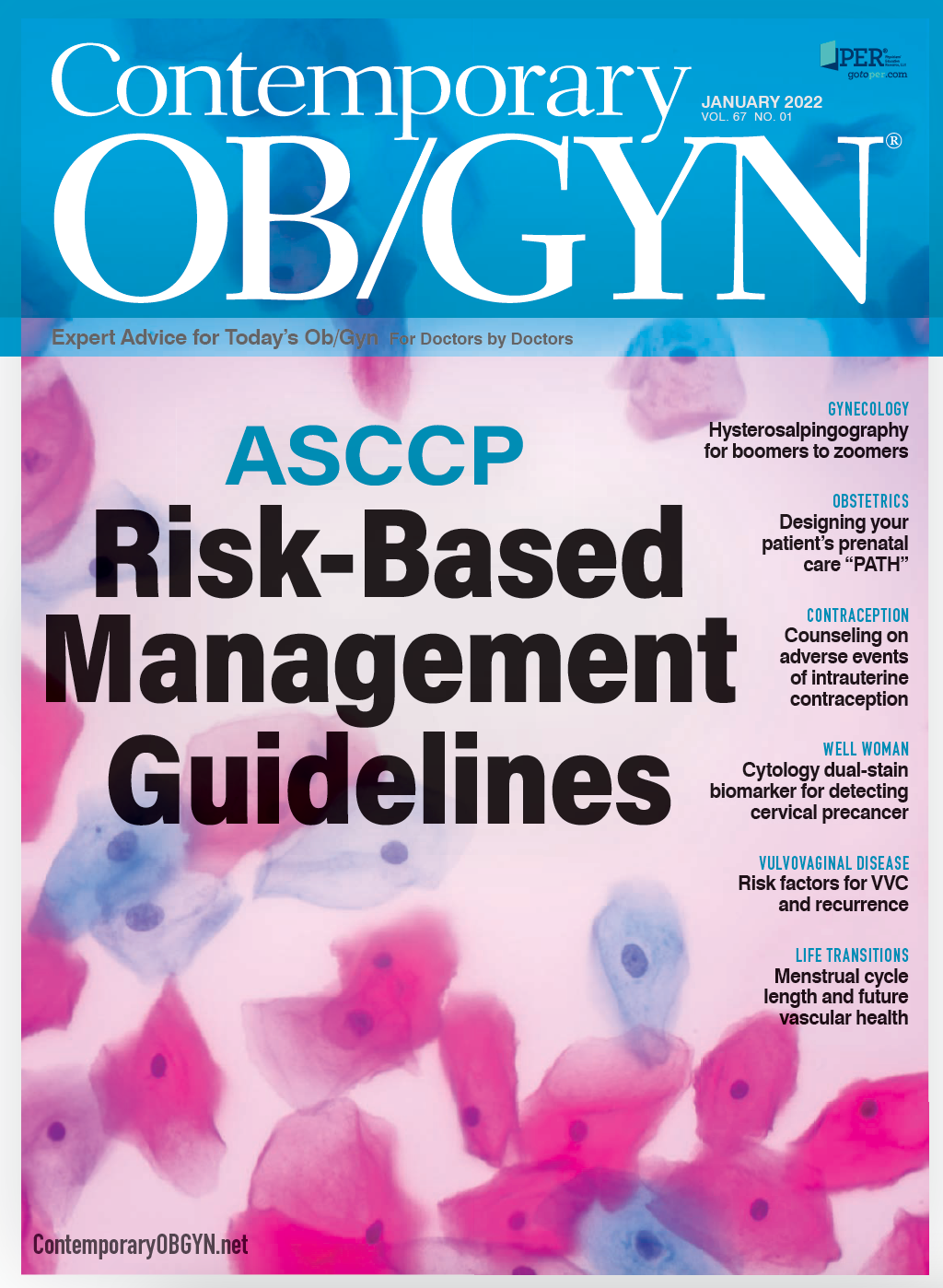Hysterosalpingography for boomers to zoomers
Although the hysterosalpingogram (HSG) is the oldest special radiologic procedure, first performed over 110 years ago, it remains an essential part of the evaluation of the infertile couple.
Luis R. Hoyos, MD
IVF Florida Reproductive Associates, Margate, FL, Department of Obstetrics & Gynecology, Florida International University Herbert Wertheim College of Medicine, Miami, Florida

Peter A. Ory, MD
Tacoma Radiological Associates, Tacoma, Washington (Retired)

Steven J. Ory, MD
IVF Florida Reproductive Associates, Margate, FL, Department of Obstetrics & Gynecology, Florida International University Herbert Wertheim College of Medicine, Miami, Florida

Although the hysterosalpingogram (HSG) is the oldest special radiologic procedure, first performed over 110 years ago, it remains an essential part of the evaluation of the infertile couple.1 The vast majority of practicing gynecologists and radiologists from the baby boomer generation (boomers) through generation Z (zoomers) have had some experience with it at some point during their careers. Over this interval, it has undergone considerable refinement and modification with significant advances in image quality and safety.
In essence, an HSG represents a radiographic evaluation of the uterine cavity and fallopian tubes using real-time outpatient fluoroscopy with injection of a radio-opaque contrast agent through the cervical canal.1,2 When the procedure is performed optimally, one can visualize the cervical canal, uterine cavity contour, and the uterine and tubal lumina, including the cornual, isthmic, and ampullary segments, and determine
tubal patency.1,2
Patient preparation and contraindications
Although there is some variation in preference for cycle timing, HSGs are typically performed between menstrual cycle days 5 to 12.
There are 2 contraindications for carrying out an HSG: pregnancy and an active pelvic infection. For pregnancy, performing the procedure during the early follicular phase following the cessation of menstrual bleeding is an effective avoidance measure. The endometrial lining is typically thin at this time which also facilitates image interpretation.1,3
Unanticipated pregnancy always remains a possibility but performing the procedure in the follicular phase, usually after obtaining a negative pregnancy test, makes it very unlikely. A brief pelvic exam to check for mucopurulent cervical discharge and cervical motion tenderness may generally be sufficient to exclude the presence of an active pelvic infection.
Additional efforts are directed toward reducing the risk of the rare postprocedure infection, which may occur in 1.4% to 3.4% of cases.4 Patients who have dilated fallopian tubes at the time of the procedure are at higher risk for this complication (11%) and prescribing an appropriate antibiotic such as doxycycline 100 mg twice daily for 5 days is commonly recommended in this setting.4
In addition, it is recommended that patients with a history of previous pelvic infection also be started on doxycycline before the procedure and that it be continued if dilated fallopian tubes are noted.4 Otherwise, in patients with no history of pelvic infection and without evidence of dilated fallopian tubes, antibiotics are not required.4
During the procedure, transient discomfort is common and most frequently happens during instillation of the contrast medium into the uterine cavity and tubal spilling.5,6 It is usually described as crampy in nature, and if it occurs, its intensity may vary from mild to severe.
In terms of pharmacologic pain prophylaxis, there is no evidence that oral nonopioid analgesics (eg, NSAIDs) reduce pain during the procedure.7
However, it has been recently suggested that premedication with hyoscine-N-butylbromide, an antispasmodic, anticholinergic drug, effectively reduces pain during and after HSG and may also decrease the rate of proximal tubal obstruction (false occlusion) presumed to be due to transient proximal tubal spasm.8,9
Type of contrast agent
HSGs were initially performed with oil-soluble contrast media (eg, lipiodol), which have been largely replaced by water-soluble contrast agents due to the absence of complications such as embolism and granuloma formation.2 These were primarily developed for intravascular use, but they are also utilized to image the genitourinary tract and other anatomical sites.10
A greater safety and tolerance profile has been developed for water-soluble contrast agents by moving away from those that are ionic and progressively reducing osmolality. Initial agents were hyperosmolar (> 1000 mOsmol/kg) and ionic. Subsequently, low-osmolar ionic and low-osmolar nonionic water-soluble contrast agents became available.11
Examples of early ionic hyperosmolar contrast agents include diatrizoate meglumine/iodipamide meglumine (Sinografin), metrizoate (Isopaque), iothalamate meglumine (Conray) and iodamide with an osmolality of 1500 to 2100 mOsm/kg compared with the 275 to 290 mOsm/kg found in plasma.10 Agents with lower osmolality, although still ionic, such as ioxaglate meglumine/ioxaglate sodium (Hexabrix), were developed later. These were followed by nonionic agents with 2 to 3 times the osmolality of plasma, such as iopamidol (Isovue), iohexol (Omnipaque), ioversol (Optiray) and iopromide (Ultravist).10 Nonionic iso-osmolar contrast agents such as iodixanol (Visipaque) and iotrolan (Isovist) later followed.
TABLE 1. Available Water-Soluble Nonionic Low-Osmolality and Nonionic Iso-Osmolar Contrast Agents*
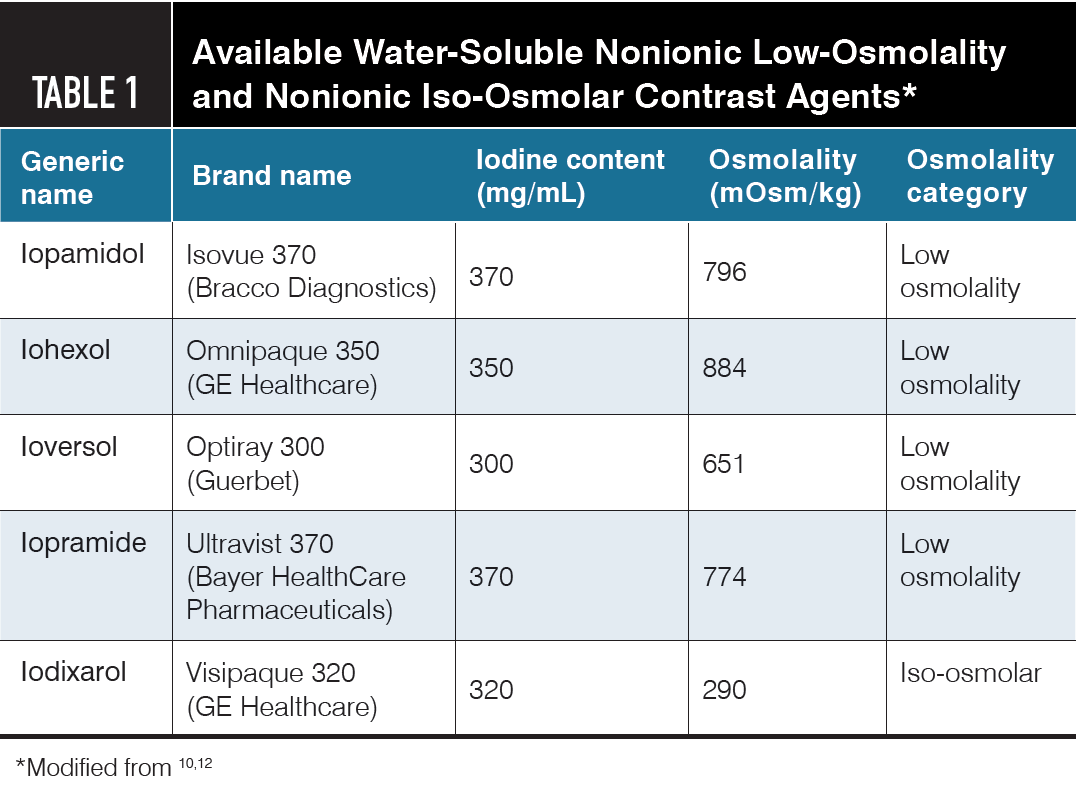
Despite a wide array of available agents, no products have emerged as preferable for general use.10 However, there is no compelling reason to support the use of older ionic and/or hyperosmolar contrast media. The more modern nonionic iso-osmolar agents have a greater safety profile and are associated with further discomfort reduction.1 Radiopacity is primarily dependent on the percentage of organically bound iodine and any contrast agent with an iodine content of 200 to 300 mg/mL reliably produces sufficient radiographic contrast for diagnostic images.11 A list of available water-soluble nonionic low-osmolality and nonionic iso-osmolar contrast agents is depicted in Table 1.
TABLE 2. Classification and Severity of Reactions to Intravenous Contrast Media*
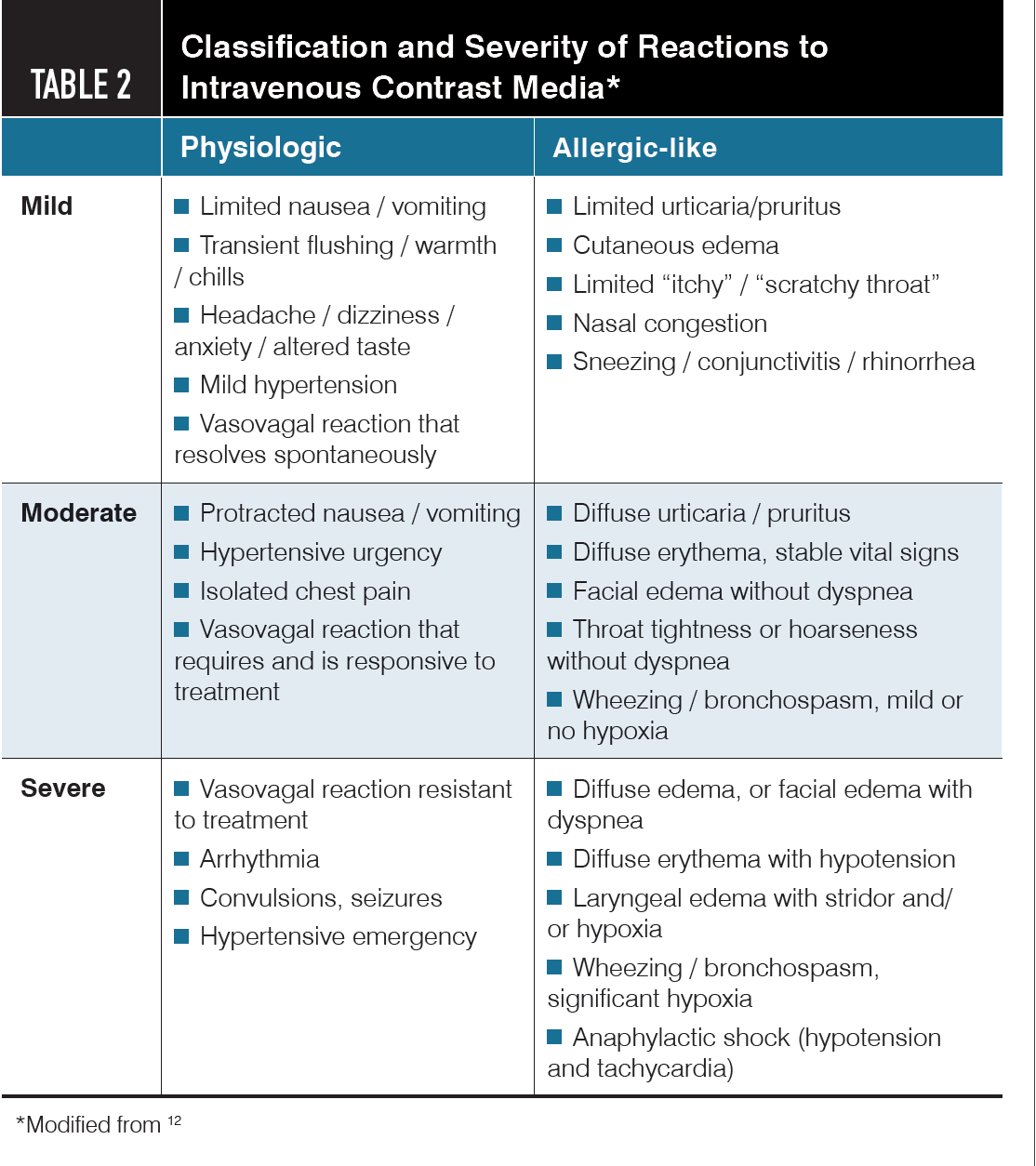
Allergic reactions to contrast agents
Reactions to intravenous contrast agents can be either physiologic or allergic-like. The frequency of both has significantly decreased as the trend from utilization of ionic high-osmolality contrast agents to nonionic, low-osmolality contrast agents has evolved.12 Subjectively, they can be categorized according to their severity as mild (self-limited without evidence of progression), moderate (more pronounced, commonly requiring medical treatment and with the potential of becoming severe if not treated), and severe (life-threatening), as depicted in Table 2.12
Physiologic reactions represent a physiologic response to the contrast agent that is likely related to specific molecular attributes leading to direct chemotoxicity, osmotoxicity (due to hyperosmolality), or molecular binding to certain activators.12 These are usually dose and concentration-dependent.12 Vasovagal reactions are characterized by hypotension and bradycardia and are considered to be physiologic reactions. They may be associated with anxiety and may occur at different stages of the procedure such as catheter placement or contrast agent injection. Most are mild and self-limited, although observation is recommended until symptoms resolve.12
Allergic-like reactions to the contrast agent differ immunologically from a “true allergic reaction” in that an antigen-antibody interaction is often not identified even though their presentations are very similar.12 Their pathogenesis and the pathway of histamine release is unclear in the majority of cases, but additives and contaminants, such as calcium-chelating substances or substances eluted from rubber stoppers in bottles or syringes, are suspected to sometimes play a role. They are likely independent of dose and concentration and occur less frequently with nonvascular than vascular administration to the point that in the former it is usually not possible to determine the true incidence, predisposing factors, or ways in which to prevent them.12,13
Allergic-like reactions to the low-osmolar nonionic contrast agents currently used for HSGs are very uncommon.3 In the literature, there are several case reports of allergic-like reactions occurring during HSGs. However, they all involved the use of oil-soluble or water-based contrast media such as ioxitalamate meglumine, Ca-Na-methylglucamine metrizoate, diatrizoate meglumine, and diatrizoate sodium which are ionic and/or hyperosmolar contrast agents.13 We were unable to find reports of such reactions occurring with the currently used generation of contrast agents. Although there is the potential for an extremely rare systemic reaction to the contrast agent if vascular intravasation inadvertently occurs, it is a hypothetical risk.
Lymphatic and vascular intravasation of nonionic water-based contrast media occur commonly and are not clinically significant.3,14
The use of premedication before intravenous administration of low-osmolar contrast agents is controversial. Conclusive data supporting the use of premedication among patients with a history of allergic-like reactions are lacking, as noted by the Royal College of Radiologists.15 The possibility of “breakthrough reactions” occurring after pretreatment is also well documented.15,16 Furthermore, physiologic reactions are not mitigated by premedication, even among patients with allergic-like reactions. The number needed to treat to avoid them would be much higher for the nonvascular administration of low-osmolar nonionic contrast.12
Guidelines from the American College of Radiology are unclear regarding nonvascular administration of iodinated contrast agents among high-risk individuals. However, expert recommendations include only doing the procedure if it is not possible to obtain the same information using a different contrast agent or test and having properly trained and equipped staff to treat any potential reaction.12,13
Therefore, if risks are deemed high, alternatives such as gadolinium in lieu of iodinated contrast agents, with which there is no cross-reactivity and which has been reported for HSGs, can be used.17
Technique
The patient should be placed in the dorsal lithotomy position on the fluoroscopic table with her arms displaced laterally or behind her head and no metal pieces of clothing interfering with the field of examination. A speculum is then placed in the vagina and the cervix is visualized and cleansed in the usual manner.
FIGURE 1. Suggested instrumentation to perform a hysterosalpingogram include a speculum, large swabs, sterile 4 x 4 gauze pads, a small solution basin, local anesthetic, single-tooth tenaculum, a syringe attached to a cannula, and a ring forceps.
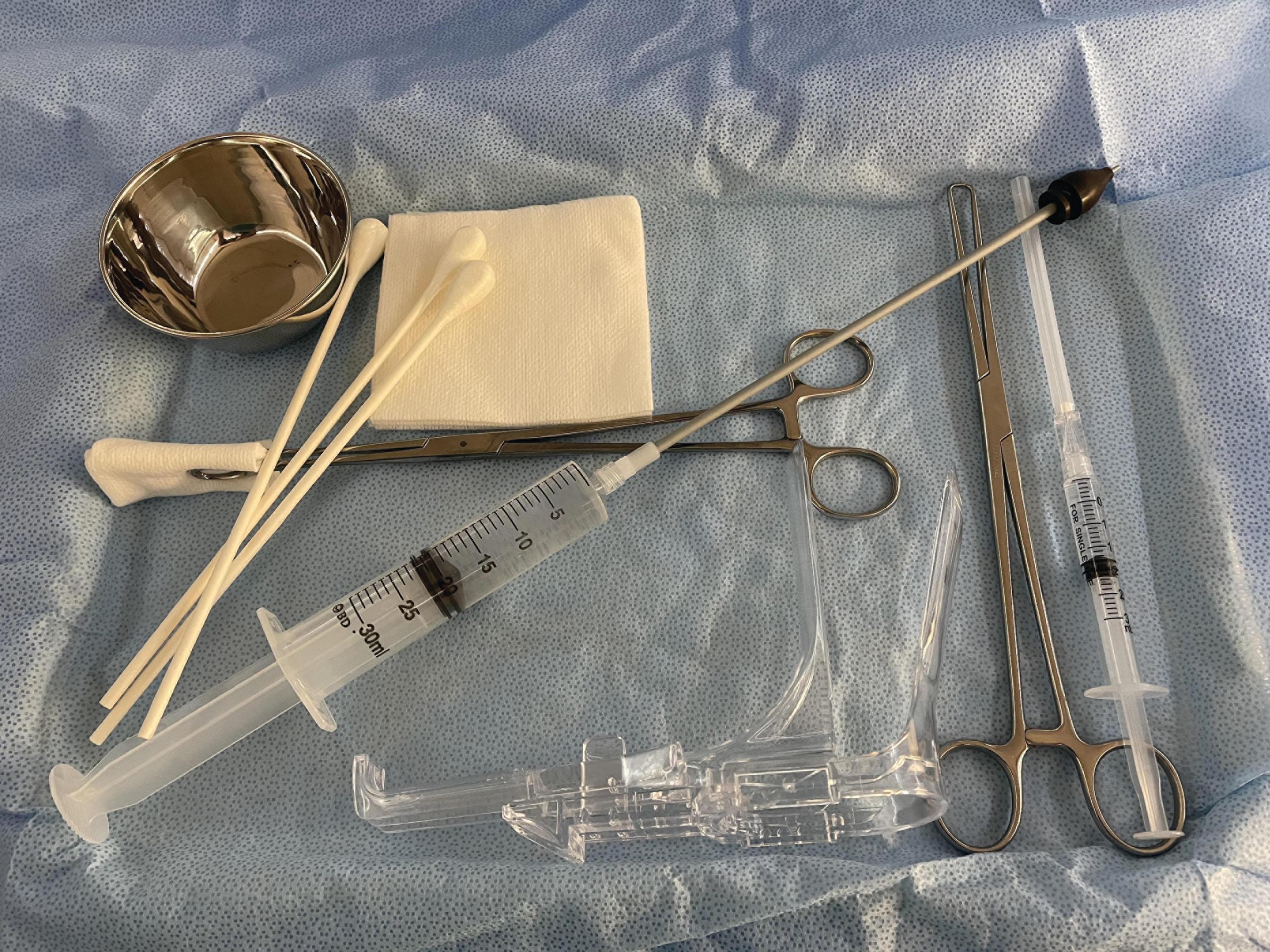
The use of a tenaculum is usually preferred to ensure that a complete antero-posterior projection of the uterus can be achieved. An intracervical block or topical lidocaine gel, both providing equal patient satisfaction, are typically applied to the anterior cervical lip prior to tenaculum placement and traction.6,18 Compared with topical lidocaine gel and placebo, pain with tenaculum placement is lower after intracervical lidocaine injection.18
Traditionally, HSGs have been performed with a metal cannula with a rubber acorn tip providing an adequate cervical seal and allowing the protruding metal tip to be placed through the cervix, and a tenaculum to fix the cannula in place and permit mobility of the uterus to ensure complete visualization (Figure 1).
Alternatively, HSGs can be performed with a plastic catheter with an inflatable balloon near the tip. A third technique utilizes a tenaculum and a thin catheter, sometimes with a shallow acorn, placed against the exocervix without protruding into the cervical canal. This method is reportedly less painful and provides complete visualization of the cavity.19 With all techniques, the contrast material should be injected through the device prior to placement to reduce the chance of injecting air into the uterine cavity and creating air bubbles which may complicate interpretation.
The preferred instrument is then positioned. If a balloon catheter is used, it is inflated fully, or at least to the extent the patient is able to tolerate.3 The speculum should then be removed to avoid obscuring the cervical canal and lower uterine segment, unless a plastic speculum is used. Gentle traction is then applied before and during contrast agent instillation to obtain a complete view of the uterus, if a tenaculum is utilized.
With the instruments in place, a scout radiograph of the pelvis is obtained before the contrast medium is instilled. Compared with cervical grasping after a paracervical block for the use of a metal cannula, balloon inflation has been described as more uncomfortable, whereas the pain associated with uterine contrast distention does not seem to vary between the 2 techniques.20-22 Topical anesthetics (eg, lidocaine gel) may reduce pain during the procedure, whereas an intracervical block does not improve pain during contrast instillation into the uterus.7
FIGURE 2. Hysterosalpingogram depicting a normal uterine contour without
intrauterine-fi lling defects and bilateral intravasation of contrast agent into the myometrial vessels and pelvic veins. Special attention is required not to confuse this with tubal fi ll and spill such as in the left aspect of this study where the difference can be noted by not being able to trace it back to the cornua.
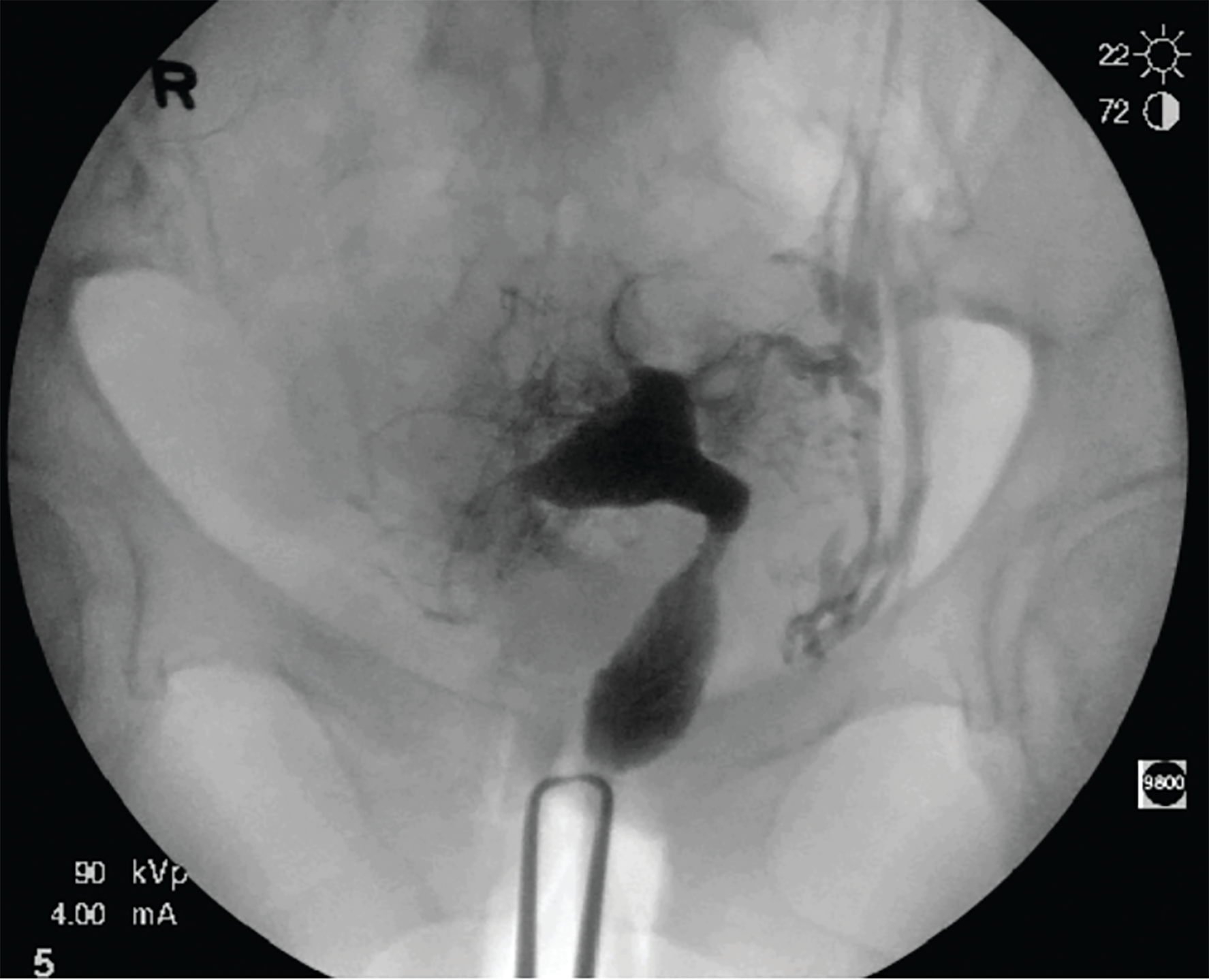
Pain can also be minimized by slowly injecting the contrast agent, which allows for intermittent fluoroscopic images of the uterus and fallopian tubes to be obtained.1,3 After the scout radiograph, at least 4 spot radiographs should be obtained, the first 1 during early filling of the uterus to evaluate for any intrauterine filling defects or contour abnormalities. The second 1 is obtained with the uterus fully distended to evaluate the shape of the uterus, although small filling defects may be obscured at this stage.
The third radiograph is to demonstrate and evaluate the fallopian tubes and the fourth is to assess for free peritoneal spill of the contrast medium. Oblique views may be required to “elongate” the tubes, displace any superimposed structures, and reveal potential uterine pathology.3 If a balloon is used, it should be deflated to permit complete visualization of the lower uterine segment.
Venous or lymphatic intravasation
Contrast intravasation may occur when the contrast agent passes from the uterine cavity into the myometrial vessels and pelvic veins (Figure 2). It occurs more frequently in the presence of fibroids or tubal obstruction or if the contrast agent is administered too quickly or forcefully.1 Radiographically, it may appear as the filling of multiple thin beaded channels that follow an ascending course.11 When intravasation occurs in the uterine and/or ovarian veins, it may be mistaken for tubal filling resulting in a false-positive result, which is why it is very important to carefully analyze the images in this situation.11 No adverse effects of intravasation of water-based contrast agents have
been reported.1,3,14
Conclusion
Hysterosalpingography is a safe procedure that is an essential element of an infertility evaluation. Although saline infusion sonography with or without 3-dimensional ultrasound may provide superior sensitivity for uterine pathology, HSG remains the gold standard for assessing tubal pathology. Significant improvements have enhanced safety and resolution, particularly in regard to the contrast agents used. The use of iso-osmolar nonionic contrast agents—Visipaque 320 being the only one available in the US—or at least low-osmolality nonionic contrast agents which are associated with less reactions and discomfort should be the accepted standard.
Discomfort remains the biggest drawback to HSGs. We believe that it can be reduced by utilizing a soft cannula that does not protrude through the cervix. In addition, the use of prophylactic hyoscine for pain reduction and potentially reducing the incidence of proximal tubal spasm should be considered.
Regarding instrumentation, we favor the use of a cannula with an acorn tip along with an intracervical tenaculum to correct any uterine flexion and allow optimal evaluation of the lower uterine segment. Topical anesthetics (eg, lidocaine gel) or an intracervical block prior to tenaculum placement are also recommended.
__
References
- Chalazonitis A, Tzovara I, Laspas F, Porfyridis P, Ptohis N, Tsimitselis G. Hysterosalpingography: technique and applications. Curr Probl Diagn Radiol. 2009;38(5):199-205. doi:10.1067/j.cpradiol.2008.02.003
- Baramki TA. Hysterosalpingography. Fertil Steril. 2005;83(6):1595-1606. doi:10.1016/j.fertnstert.2004.12.050
- Simpson WL Jr, Beitia LG, Mester J. Hysterosalpingography: a reemerging study. Radiographics. 2006;26(2):419-431. doi:10.1148/rg.262055109
- ACOG Practice Bulletin No. 195: prevention of infection after gynecologic procedures. Obstet Gynecol. 2018;131(6):e172-e189. doi:10.1097/AOG.0000000000002670
- Unlu BS, Yilmazer M, Koken G, et al. Comparison of four different pain relief methods during hysterosalpingography: a randomized controlled study. Pain Res Manag. 2015;20(2):107-111. doi:10.1155/2015/306248
- Robinson RD, Casablanca Y, Pagano KE, Arthur NA, Bates GW, Propst AM. Intracervical block and pain perception during the performance of a hysterosalpingogram: a randomized controlled trial. Obstet Gynecol. 2007;109(1):89-93. doi:10.1097/01.AOG.0000247645.52211.41
- Hindocha A, Beere L, O’Flynn H, Watson A, Ahmad G. Pain relief in hysterosalpingography. Cochrane Database Syst Rev. 2015; 2015(9):CD006106. doi:10.1002/14651858.CD006106.pub3
- Aboshama RA, Shareef MA, AlAmodi AA, et al. The effect of hyoscine-N-butylbromide on pain perception during and after hysterosalpingography in infertile women: a systematic review and meta-analysis of randomised controlled trials. Hum Fertil (Camb). Published online Nov 3, 2020. doi:10.1080/14647273.2020.1842915
- Jitchanwichai A, Soonthornpun K. Effect of premedication hyoscine-N-butylbromide before hysterosalpingography for diagnosis of proximal tubal obstruction in infertile women: a randomized double-blind controlled trial. J Minim Invasive Gynecol. 2019;26(1):110-116. doi:10.1016/j.jmig.2018.03.034
- Peart JM, Sim RG, Hofman PL. Therapeutic effects of hysterosalpingography contrast media in infertile women: what do we know about the H2O in the H2Oil trial and why does it matter? Hum Reprod. 2021;36(3):529-535. doi:10.1093/humrep/deaa325
- Mohd Nor H, Jayapragasam K, Abdullah B. Diagnostic image quality of hysterosalpingography: ionic versus non ionic water soluble iodinated contrast media. Biomed Imaging Interv J. 2009;5(3):e29. doi:10.2349/biij.5.3.e29
- ACR Committee on Drugs and Contrast Media. ACR Manual on Contrast Media. American College of Radiology; 2021.
- Davis PL. Anaphylactoid reactions to the nonvascular administration of water-soluble iodinated contrast media. AJR Am J Roentgenol. 2015;204(6):1140-1145. doi:10.2214/AJR.15.14507
- La Fianza A, Fachinetti C, Gorone MSP. Venous-lymphatic intravasation during hysterosalpingography using hydrosoluble contrast medium. Journal of Women’s Imaging. 2005;7(1):38-43. doi:10.1097/01.jwi.0000159508.18689.84
- Board of the Faculty of Clinical Radiology. Standards for intravascular contrast agent administration to adult patients, third edition. The Royal College of Radiologists. 2010.
- Tramèr MR, von Elm E, Loubeyre P, Hauser C. Pharmacological prevention of serious anaphylactic reactions due to iodinated contrast media: systematic review. BMJ. 2006;333(7570):675. doi:10.1136/bmj.38905.634132.AE
- Belt MM, Rodenko G, Taylor K, Maguire C, Bello S. Use of gadolinium for hysterosalpingography in iodine allergic women: a case-control study. Fertil Steril. 2008;90(3):835-838. doi:10.1016/j.fertnstert.2007.02.019
- Goldthwaite LM, Baldwin MK, Page J, et al. Comparison of interventions for pain control with tenaculum placement: a randomized clinical trial. Contraception. 2014;89(3):229-233. doi:10.1016/j.contraception.2013.11.018
- Mansour R, Nada A, El-Khayat W, Abdel-Hak A, Inany H. A simple and relatively painless technique for hysterosalpingography, using a thin catheter and closing the cervix with the vaginal speculum: a pilot study. Postgrad Med J. 2011;87(1029):468-471. doi:10.1136/pgmj.2010.106658
- de Mello JFL Sr, Abrao MS, Cerri GG, de Barros N. Evaluation of pain in three hysterosalpingography techniques: metal cannula with and without paracervical blockage and balloon catheter. AJR Am J Roentgenol. 2006;187(1):86-89. doi:10.2214/AJR.05.0392
- Stoop D, De Brucker M, Haentjens P, Talebian A, de Mey J, Devroey P. Fast-release orodispersible tramadol as analgesia in hysterosalpingography with a metal cannula or a balloon catheter. Hum Reprod. 2010;25(6):1451-1457. doi:10.1093/humrep/deq076
- Varpula M. Hysterosalpingography with a balloon catheter versus a cannula: evaluation of patient pain. Radiology. 1989;172(3):745-747. doi:10.1148/radiology.172.3.2772182
